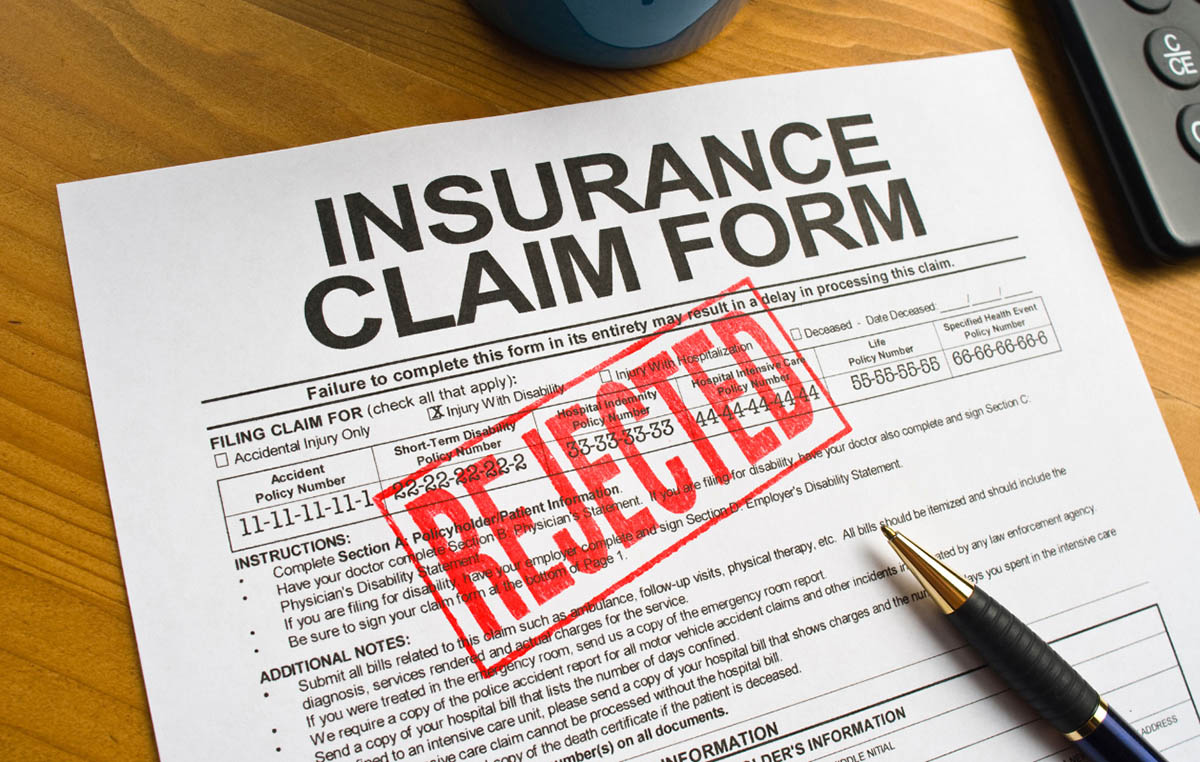

Finance
How To File A Renter’s Insurance Claim
Published: November 17, 2023
Learn how to file a renter's insurance claim and protect your finances. Our step-by-step guide will help you navigate the process smoothly.
(Many of the links in this article redirect to a specific reviewed product. Your purchase of these products through affiliate links helps to generate commission for LiveWell, at no extra cost. Learn more)
Table of Contents
- Introduction
- Understanding Renter’s Insurance Claims
- Step 1: Assessing the Damage or Loss
- Step 2: Documenting the Incident
- Step 3: Notifying the Insurance Company
- Step 4: Meeting with an Insurance Adjuster
- Step 5: Providing Proof of Ownership or Value
- Step 6: Cooperating with the Investigation
- Step 7: Negotiating the Claim
- Step 8: Receiving Your Claim Settlement
- Conclusion
Introduction
Renter’s insurance is an essential financial safety net that protects tenants in the event of damage, loss, or theft of personal belongings. However, knowing how to file a renter’s insurance claim can be a daunting task for many. Understanding the process and steps involved can help streamline the claim process and ensure a smooth and successful outcome.
In this article, we will guide you through the process of filing a renter’s insurance claim, providing you with valuable insights and tips to navigate the sometimes complex insurance landscape. From assessing the damage or loss to negotiating the claim settlement, we will break down each step, equipping you with the knowledge and confidence to handle the claim process with ease.
It’s important to note that every insurance policy and provider may have slightly different procedures and requirements. Therefore, it’s always advisable to refer to your specific policy and contact your insurance provider for detailed instructions. However, the general steps outlined here can serve as a helpful guideline for filing a renter’s insurance claim.
Understanding Renter’s Insurance Claims
Before diving into the process of filing a renter’s insurance claim, it’s crucial to have a solid understanding of what renter’s insurance covers. Renter’s insurance is designed to protect tenants and their personal belongings in case of unexpected events such as theft, fire, water damage, or natural disasters.
Most renter’s insurance policies cover three primary areas: personal property, liability, and additional living expenses.
- Personal Property: This coverage helps reimburse you for the cost of repairing or replacing your personal belongings in case they are damaged, lost, or stolen. This can include furniture, clothing, electronics, and other valuable items.
- Liability: Liability coverage protects you in the event that someone injures themselves while on your rented property and holds you responsible. It can help cover medical expenses, legal fees, and potential damages awarded in a lawsuit.
- Additional Living Expenses: If your rented property becomes uninhabitable due to a covered event, such as a fire, renter’s insurance can help cover the costs of temporary accommodation, meals, and other necessary expenses until you can move back in.
Understanding what your renter’s insurance policy covers and the limits of your coverage is vital. Familiarize yourself with the terms and conditions, deductibles, and exclusions specified in your policy.
When it comes to filing a renter’s insurance claim, it’s essential to gather as much evidence and documentation as possible to support your claim. This includes photographs or videos of your damaged or stolen items, receipts or proof of purchase, police reports (in the case of theft), and any other relevant documentation.
Now that we’ve established the importance of understanding renter’s insurance coverage and the need for proper documentation, let’s move on to the step-by-step process of filing a renter’s insurance claim.
Step 1: Assessing the Damage or Loss
The first step in filing a renter’s insurance claim is to assess the extent of the damage or loss. This involves carefully inspecting your rental property and documenting any damage to your personal belongings.
Start by taking photographs or videos of the affected areas and any damaged items. This visual evidence will be crucial when filing your claim and substantiating the value of your losses. Make sure to capture clear images that clearly show the damage or condition of your possessions.
If possible, create a detailed inventory of the damaged or lost items. Include information such as the item’s description, brand, model, and approximate value at the time of the incident. This inventory will help you provide accurate information to your insurance company and expedite the claims process.
It’s important to note that you should not attempt to repair or dispose of any damaged items until your insurance provider has assessed them. They may require a physical inspection or request additional evidence, so it’s best to wait for their instructions.
To ensure that you don’t miss any damaged items during the assessment, go room by room and check every corner and closet. Look for signs of water damage, fire or smoke damage, theft, or any other incidents covered by your policy. Be thorough and meticulous in your examination.
If you encounter difficulties in assessing the damage or need assistance, consider contacting a professional, such as a restoration company or a contractor, who can provide expert advice and help document the extent of the damage.
Remember, the more detailed and accurate your assessment of the damage or loss, the smoother the claims process will be. Take the time to thoroughly document the situation before moving on to the next steps.
Step 2: Documenting the Incident
After assessing the damage or loss, the next step in filing a renter’s insurance claim is to document the incident in detail. This involves gathering all relevant information surrounding the event that led to the damage or loss of your personal belongings.
Start by writing a detailed account of what happened. Include the date, time, and a chronological description of the incident. Be specific and provide as much information as possible, including any contributing factors or circumstances that may have led to the damage or loss.
Additionally, if there were any witnesses present during the incident, try to obtain their contact information. Their testimony can provide crucial support for your claim and help validate the sequence of events.
In cases of theft or vandalism, it’s important to file a police report. Contact your local law enforcement agency and provide them with all relevant details of the incident. Obtain a copy of the report, as it will serve as official documentation and help substantiate your claim.
As mentioned earlier, photographic or video evidence is valuable in documenting the incident. Take pictures or record videos of the scene, showing the damage or any signs of forced entry, if applicable. This visual evidence will assist your insurance provider in understanding the extent of the damage and the circumstances surrounding the incident.
Keep all receipts and invoices related to any expenses incurred as a result of the incident. This includes receipts for temporary accommodation, meals, or any immediate repairs you had to make to the property to prevent further damage. These documents will be vital in getting reimbursed for these out-of-pocket expenses.
If you had any conversations or communications (such as emails or text messages) with relevant parties, such as landlords or property management, regarding the incident, make sure to keep records of those as well.
By thoroughly documenting the incident and gathering all relevant information, you can provide comprehensive support for your claim and increase your chances of a successful resolution.
Step 3: Notifying the Insurance Company
Once you have assessed the damage or loss and documented the incident, the next crucial step in filing a renter’s insurance claim is to notify your insurance company as soon as possible. Promptly contacting your insurance provider is vital to ensure that the claim process begins smoothly and in a timely manner.
Refer to your renter’s insurance policy or contact your insurance agent to find out the specific method or procedure for reporting a claim. Most insurance companies have a designated claims department or a toll-free claims hotline that you can reach out to.
When speaking with your insurance company, be prepared to provide detailed information about the incident. This includes the date and time of the event, a description of what happened, and any supporting evidence you have gathered. The more accurate and comprehensive your information, the better your chances of a successful claim.
During the conversation, ask your insurance company about the necessary paperwork or forms required to initiate the claim process. They may provide you with specific claim forms to fill out or direct you to an online portal where you can submit the necessary information electronically.
Make sure to ask about any deadlines or timeframes for providing documentation and submitting your claim. Adhering to these timelines will help avoid any unnecessary delays or complications in the claims process.
Remember to keep a record of all communications with your insurance company, including the date, time, and name of the representative you spoke with. This can be helpful for future reference or in case any disputes arise during the claim process.
It’s worth noting that if your rental property is managed by a landlord or property management company, it’s advisable to inform them about the incident as well. They may have insurance coverage for the property itself, and their cooperation may be necessary for the claims process.
By promptly notifying your insurance company and initiating the claims process, you show your proactive approach and set the foundation for a smooth resolution of your renter’s insurance claim.
Step 4: Meeting with an Insurance Adjuster
After notifying your insurance company about the incident and filing your renter’s insurance claim, the next step is usually to schedule a meeting with an insurance adjuster. An insurance adjuster is the representative assigned by the insurance company to assess the validity and value of your claim.
The insurance adjuster will typically contact you to arrange a date and time for the meeting. This meeting may take place in person or, in some cases, over the phone or through video conference. During this meeting, the adjuster will examine the evidence you have provided, inspect the damaged property, and gather additional information related to your claim.
It’s crucial to come prepared for the meeting with the insurance adjuster. Begin by reviewing and organizing all the documentation related to your claim, including the incident report, photographs, receipts, and any other supporting evidence you have. Make sure to have multiple copies available for the adjuster’s review.
During the meeting, be cooperative, honest, and provide as much detail as possible. Answer any questions the adjuster may have and offer any additional information that can help support your claim. It’s important to remain calm and professional, even if there are disagreements or differing opinions regarding the value of the loss.
The adjuster may also ask for any additional documentation or evidence during the meeting. Be prepared to provide any requested information promptly, as it can expedite the claims process.
It’s beneficial to take notes during the meeting to document the discussions, any resolutions reached, and any promises made by the adjuster. T
Step 5: Providing Proof of Ownership or Value
When filing a renter’s insurance claim, it’s essential to provide proof of ownership or the value of the items that were damaged, lost, or stolen. This documentation serves as evidence to support the validity of your claim and can help ensure that you receive fair compensation.
Begin by gathering any receipts, invoices, or purchase records for the items you are claiming. These documents not only establish proof of ownership but also provide information about the value of the items at the time of purchase. Include as many details as possible, such as the item’s description, brand, model, and price paid.
If you no longer have receipts or invoices, you can gather other types of documentation to support your claim. This can include credit card statements showing the purchase transactions, product manuals, warranty certificates, or even photographs of the items in your possession prior to the incident.
For high-value items, such as jewelry, artwork, or electronics, it can be beneficial to provide appraisals or professional assessments of their worth. These appraisals should be conducted by certified professionals to establish an accurate value for insurance purposes.
If the damaged or lost items are older or have appreciated in value over time, you may need to provide evidence of their current value. This can be challenging, but you can consult with experts such as antique dealers, art appraisers, or specialists in specific collectibles who can provide an estimate of their current worth.
When presenting your proof of ownership or value, make sure to organize and label your documentation clearly. Create a list with item descriptions, values, and corresponding evidence to facilitate the claims process for the insurance adjuster.
Keep in mind that the insurance company may request additional proof or documentation during the claims process. Stay in communication with your assigned adjuster and promptly provide any requested information to avoid any unnecessary delays or complications in the evaluation and settlement of your claim.
By providing thorough and convincing evidence of ownership or value, you enhance your chances of receiving appropriate compensation for the items covered by your renter’s insurance policy.
Step 6: Cooperating with the Investigation
Once you have provided proof of ownership or value and submitted your documentation, the insurance company will start investigating your renter’s insurance claim. This step is crucial for them to validate the legitimacy of your claim and assess the extent of the damages or losses.
Cooperating fully with the investigation is essential throughout this process. It’s important to promptly respond to any requests for additional information or documentation from the insurance company. Failure to cooperate may result in delays or even denials of your claim.
The insurance company may assign an investigator to your case. This investigator may visit the property to gather evidence, interview witnesses, or analyze any relevant documentation. They may also assess the circumstances surrounding the incident to determine if any fraudulent activities were involved.
During the investigation, be prepared to provide any additional information or documentation that may be requested. This could include providing access to the damaged property for further inspection or answering follow-up questions related to the incident.
It’s important to be honest and transparent during the investigation. Providing false or misleading information can have severe consequences and may result in your claim being denied. Remember that the purpose of the investigation is to establish the validity and accuracy of your claim.
If you have any concerns or questions during the investigation process, don’t hesitate to communicate with your insurance company or assigned adjuster. They can provide clarification and guidance, ensuring that you understand the progress and status of your claim.
Additionally, keep a record of all interactions and communications related to the investigation. This includes documenting the date, time, and nature of the conversations, as well as the names of the individuals you spoke with. These records can serve as a reference if any discrepancies or issues arise later in the process.
Remember that cooperating fully with the investigation demonstrates your willingness to work with the insurance company and can help ensure a smooth and successful resolution of your renter’s insurance claim.
Step 7: Negotiating the Claim
After the investigation is completed and the insurance company has assessed the validity and value of your renter’s insurance claim, the next step is to negotiate the settlement. This is an important stage where you and the insurance company work together to reach a fair and satisfactory resolution.
Once the insurance company has evaluated the evidence and documentation you provided, they will make a settlement offer. This offer represents the amount they believe is appropriate to compensate for the damages or losses covered by your policy. Review the offer carefully and compare it to your own assessment of the value of your claim.
If you believe that the offered settlement is inadequate, you have the right to negotiate with the insurance company to seek a higher amount. This process typically involves presenting additional evidence or information to support your claim for a higher settlement.
During negotiations, be prepared to explain your reasoning and provide any additional documentation that supports your valuation of the damages or losses. This can include receipts, appraisals, or expert assessments of the value of specific items. The goal is to present a compelling case that justifies your desired settlement amount.
It’s important to maintain clear and respectful communication during the negotiation process. Keep in mind that insurance adjusters are trained professionals who have experience assessing claims. Be open to their feedback and willing to consider their perspective. However, if you have strong evidence supporting your valuation, be assertive in advocating for the settlement you believe is fair.
Keep track of all negotiations and any changes made to the settlement offer. Document the dates, times, and details of any discussions or counteroffers exchanged between you and the insurance company. This will help ensure transparency and provide a record of the negotiation process.
In some cases, a compromise may need to be reached. It’s important to carefully consider any offers made by the insurance company and evaluate your options. Consult with a legal professional or a public adjuster if you feel that you are not being treated fairly or if you need additional guidance in the negotiation process.
Ultimately, the goal of negotiating the claim is to reach a mutually acceptable settlement that adequately compensates you for your damages or losses. By being prepared, assertive, and open to discussions, you can work towards a resolution that satisfies both parties involved.
Step 8: Receiving Your Claim Settlement
After negotiating the terms of your renter’s insurance claim, you will reach a settlement agreement with the insurance company. This marks the final step in the claims process and paves the way for you to receive the compensation to which you are entitled.
Once you have agreed upon a settlement amount, the insurance company will provide you with a formal settlement offer. This offer will detail the agreed-upon amount and any terms or conditions associated with the settlement. Take the time to review this document carefully and ensure that all agreed-upon terms are accurately represented.
If you have any questions or concerns regarding the settlement offer, seek clarification from the insurance company. It’s important to have a clear understanding of the agreement before you accept it.
Once you have reviewed and accepted the settlement offer, you will typically be asked to sign a release of liability form. This form acknowledges your acceptance of the settlement and waives your right to pursue any further claims related to the incident.
Before signing the release, make sure that you are satisfied with the settlement amount and that it adequately covers your damages or losses. Once the release is signed and submitted, it may be challenging to revisit or revise the settlement agreement.
After the insurance company receives the signed release form, they will initiate the process to release your claim settlement funds. The timing of receiving your settlement may vary depending on the insurance company’s procedures and any applicable legal requirements.
Be sure to inquire about the specific timeline for receiving your settlement funds. Some insurance companies may offer direct deposit options or issue a check, while others may require additional processing time.
Once you have received your claim settlement, review the amount to ensure it aligns with the agreed-upon terms. If you have any concerns or discrepancies, contact your insurance company immediately to address the issue.
It’s important to responsibly allocate and utilize your claim settlement funds. Use the funds to repair or replace the damaged or lost items as necessary. If you have incurred any out-of-pocket expenses related to the incident, such as temporary accommodations or emergency repairs, ensure that you allocate funds to cover those costs as well.
Finally, take the time to reflect on your experience and the claims process. Consider any lessons learned and evaluate whether there are any preventative measures you can take in the future to mitigate risks and protect your personal belongings.
By completing the process of receiving your claim settlement, you can put the incident behind you and move forward with confidence, knowing that you have been fairly compensated for your losses according to your renter’s insurance policy.
Conclusion
Filing a renter’s insurance claim can be a complex and sometimes overwhelming process. However, by understanding the steps involved and being prepared, you can navigate the claims process with confidence and increase your chances of a successful outcome.
Remember to assess the damage or loss, document the incident thoroughly, and notify your insurance company promptly. Cooperate fully with the investigation and provide proof of ownership or value to substantiate your claim. Engage in negotiations and advocate for a fair settlement that adequately compensates for your damages or losses.
Throughout the process, maintain clear and respectful communication with the insurance company and keep detailed records of all interactions and documentation. Seek professional advice if necessary and take the time to understand your renter’s insurance policy and coverage.
By following these steps and being proactive, you can increase your chances of a smooth and satisfactory resolution to your renter’s insurance claim. Remember, each claim is unique, and it’s always important to refer to your specific policy and consult with your insurance provider for personalized guidance.
Lastly, it’s essential to review your renter’s insurance policy periodically and make any necessary updates to ensure it accurately reflects your current needs and possessions. Being prepared and informed is the key to protecting yourself and your belongings in the event of unforeseen incidents.
With the right knowledge and understanding, you can confidently navigate the renter’s insurance claims process and reap the benefits of having financial protection and peace of mind as a tenant.














